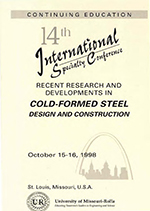Session Dates
15 Oct 1998
Abstract
Certain cold-formed sections like channels and zees, when subjected to bending in the plane of the web, often fail in laboratory tests at a load less than that predicted by standard specification equations. The mode of failure is an upward movement of the compression flange and lip relative to the web, which may remain fairly plane. When bends which were right angles change dramatically under load, the section changes shape, or distorts, resulting in a reduction of the section stiffness followed by buckling of the flange. Such a failure is referred to as "distortional buckling". An analytical solution to the distortional buckling problem has been proposed by Hancock of the University of Sydney. This method was used to calculate distortional buckling capacities of around 200 shapes and a curve was fit to the results. Finally, a simplified expression was developed to check this limit state with minimal effort. Several full-scale tests were performed on channels and zees of various thicknesses and bracing conditions to verify the Hancock method.
Department(s)
Civil, Architectural and Environmental Engineering
Research Center/Lab(s)
Wei-Wen Yu Center for Cold-Formed Steel Structures
Meeting Name
14th International Specialty Conference on Cold-Formed Steel Structures
Publisher
University of Missouri--Rolla
Document Version
Final Version
Rights
© 1998 University of Missouri--Rolla, All rights reserved.
Document Type
Article - Conference proceedings
File Type
text
Language
English
Recommended Citation
Ellifritt, Duane S.; Glover, Robert L.; and Hren, Jonathan D., "A Simplified Model for Distortional Buckling of Channels and Zees in Flexure" (1998). CCFSS Proceedings of International Specialty Conference on Cold-Formed Steel Structures (1971 - 2018). 1.
https://scholarsmine.mst.edu/isccss/14iccfsss/14iccfsss-session1/1
A Simplified Model for Distortional Buckling of Channels and Zees in Flexure
Certain cold-formed sections like channels and zees, when subjected to bending in the plane of the web, often fail in laboratory tests at a load less than that predicted by standard specification equations. The mode of failure is an upward movement of the compression flange and lip relative to the web, which may remain fairly plane. When bends which were right angles change dramatically under load, the section changes shape, or distorts, resulting in a reduction of the section stiffness followed by buckling of the flange. Such a failure is referred to as "distortional buckling". An analytical solution to the distortional buckling problem has been proposed by Hancock of the University of Sydney. This method was used to calculate distortional buckling capacities of around 200 shapes and a curve was fit to the results. Finally, a simplified expression was developed to check this limit state with minimal effort. Several full-scale tests were performed on channels and zees of various thicknesses and bracing conditions to verify the Hancock method.



